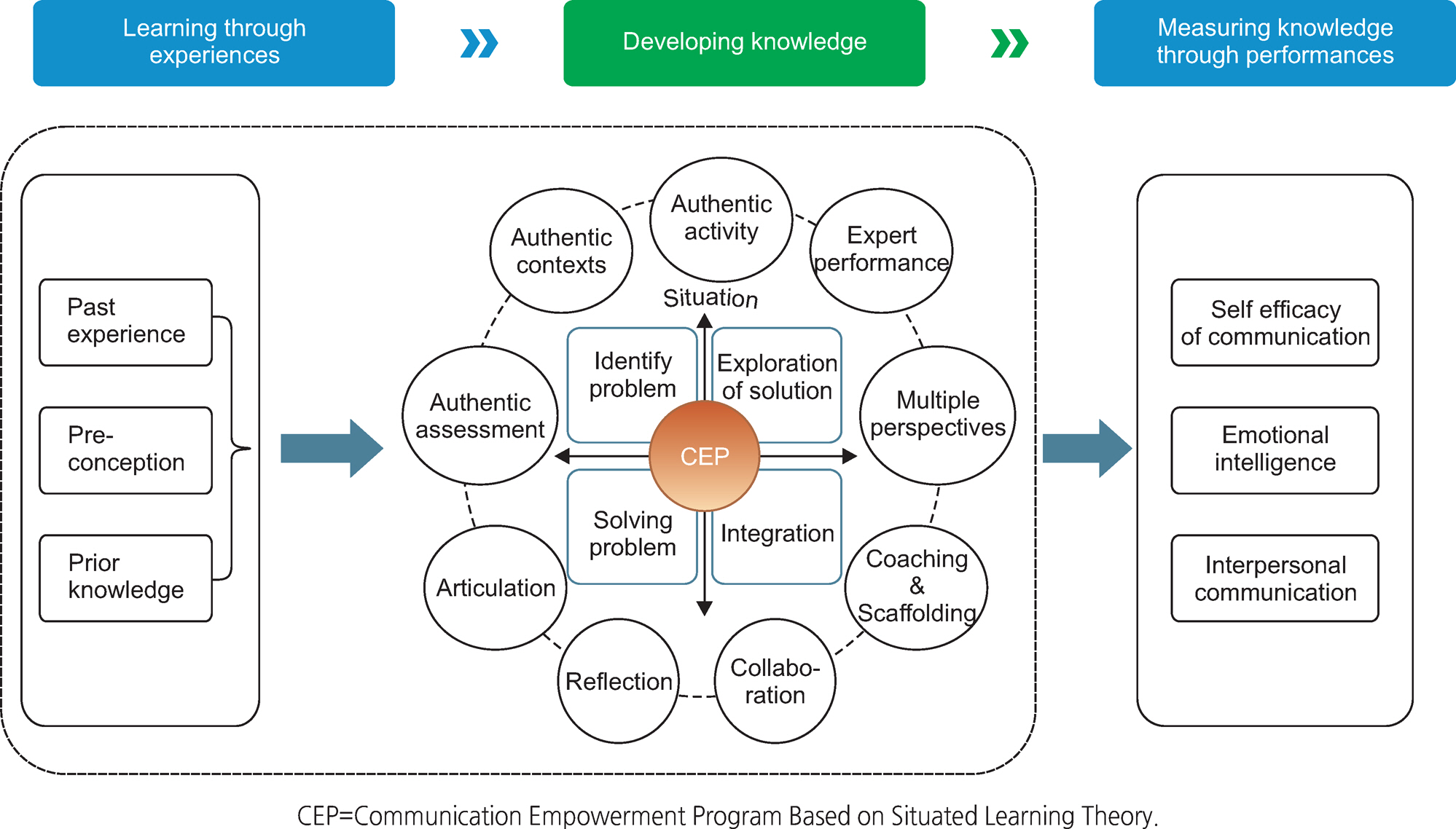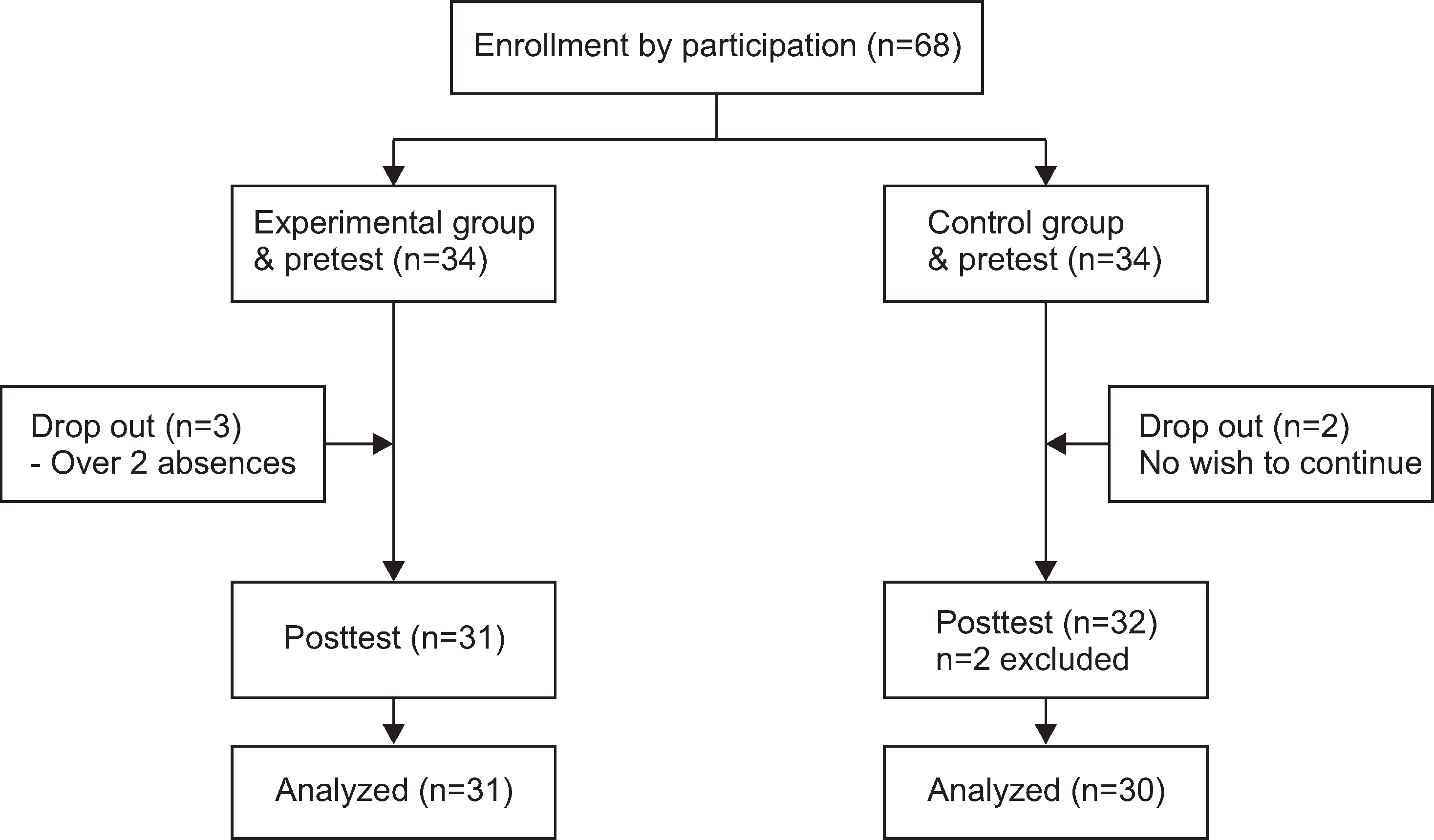J Korean Acad Nurs.
2018 Dec;48(6):708-719. 10.4040/jkan.2018.48.6.708.
Effects of Communication Empowerment Program Based on Situated Learning Theory for Nursing Students
- Affiliations
-
- 1College of Nursing · Research Institute of Nursing Science, Chonnam National University, Gwangju, Korea.
- 2College of Nursing · Institute of Health Sciences, Gyeongsang National University, Jinju, Korea. dasom7812@daum.net
- KMID: 2430597
- DOI: http://doi.org/10.4040/jkan.2018.48.6.708
Abstract
- PURPOSE
This study was conducted to examine the effects of a communication empowerment program based on situated learning theory for nursing students.
METHODS
A non-equivalent control group pretest-posttest design was used. The study participants were 61 nursing students (31 in the experimental group and 30 in the control group) from G city. Data were collected from November 3, 2015 to December 10, 2015. The experimental group received eight sessions of the program, which were scheduled twice a week, with each session lasting two hours. The data were analyzed using chi-square test, Fisher's exact test, and an independent t-test using SPSS/WIN 20.0.
RESULTS
There were significant increases in self-efficacy for communication (t=2.62, p=.011), emotional intelligence (t=2.66, p=.010), and interpersonal communication competence (t=2.87, p=.006) in the experimental group compared to the control group.
CONCLUSION
Based on the findings, our study suggests a need to include content from communication curricula or clinical communication training programs for improving undergraduate nursing students' communication skills in practice settings.
Keyword
MeSH Terms
Figure
Reference
-
References
1. Lee GJ. Communication and Nursing. 3rd ed. Seoul: Shink-wang;2014. p. 1–300.2. Park YR, Yang S. Nurse managers’ facilitative communication and nurses’ organizational commitment, job satisfaction, and empowerment. Journal of Korean Academy of Psychiatric and Mental Health Nursing. 2008; 17(3):342–352.3. Choi J, Ha NS, Park JW. The relationship between managerial characteristics of the nursing organization and organizational. Journal of Korean Academy of Nursing Administration. 2003; 9(4):625–639.4. Cho YH. Development and effects of team-based learning program on enhance of communication competence for nursing students [dissertation]. Gwangju: Chosun University;2014. p. 1–112.5. Park Y, Im SB, Kim HS. The effects of reinforced self-understanding in nursing communication curriculum. Journal of Ko- rean Academy of Psychiatric and Mental Health Nursing. 2009; 18(3):361–368.6. Kim S, Park JH, Lee HH. The development and effects of a comprehensive communication course for nursing students. Journal of Korean Academy of Nursing. 2004; 34(3):412–420. https://doi.org/10.4040/jkan.2004.34.3.412.
Article7. Korean Accreditation Board of Nursing Education. Accreditation Manual of Nursing Education. Seoul: Korean Accreditation Board of Nursing Education;2013. p. 1–11.8. Lee HS, Kim JK. Relationship among communication competence, communication types, and organizational commitment in hospital nurses. Journal of Korean Academy of Nursing Administration. 2010; 16(4):488–496. https://doi.org/10.11111/jkana.2010.16.4.488.
Article9. Kim HS, Park WJ, Ha TH. The influencing factors of interpersonal relationship in nursing students. The Journal of Korean Academic Society of Nursing Education. 2006; 12(2):229–237.10. Cho IY. The relationship of communication skill, communication self-efficacy and communication related educational needs. Journal of the Korea Academia-Industrial Cooperation Society. 2015; 16(4):2593–2601. https://doi.org/10.5762/KAIS.2015.16.4.2593.
Article11. Kim HM. The effect of the solution-focused communication training on the problem solving ability and interpersonal relationship of nursing students. Journal of Korean Academy of Psychiatric and Mental Health Nursing. 2009; 18(4):399–408.12. Park HJ, Lee KJ, Kim SS. A comparative study on the counseling self-efficacy and empathy of psychiatric nurses and general ward nurses. Health & Nursing. 2014; 26(1):9–19.13. Won JS, Shin HS. The effect of small group based communication training program on the competency of communication and the human relationship in nursing college students. Journal of East-West Nursing Research. 2008; 14(2):60–66.14. Lee NK. Narrative literature class in nursing using emotional intelligence. Journal of Qualitative Inquiry. 2018; 4(2):169–189. https://doi.org/10.30940/JQI.2018.4.2.169.
Article15. Wong CS, Law KS. The effects of leader and follower emotional intelligence on performance and attitude: An exploratory study. The Leadership Quarterly. 2002; 13(3):243–274. https://doi.org/10.1016/S1048-9843(02)00099-1.
Article16. Ha JY, Jeon SY. The effects of humanistic knowledge and emotional intelligence on communication skills of nurses. The Journal of Korean Academic Society of Nursing Education. 2016; 22(3):264–273. https://doi.org/10.5977/jkasne.2016.22.3.264.
Article17. Lee OS, Gu MO. The relationship between emotional intelligence and communication skill, clinical competence & clinical practice stress in nursing students. Journal of the Korea Academia-Industrial Cooperation Society. 2013; 14(6):2749–2759. https://doi.org/10.5762/KAIS.2013.14.6.2749.18. Choi Y, Song E, Oh E. Effects of teaching communication skills using a video clip on a smart phone on communication competence and emotional intelligence in nursing students. Archives of Psychiatric Nursing. 2015; 29(2):90–95. https://doi.org/10.1016/j.apnu.2014.11.003.
Article19. Yoo MS, Park JH, Lee SR. The effects of case-based learning using video on clinical decision making and learning motivation in undergraduate nursing students. Journal of Korean Academy of Nursing. 2010; 40(6):863–871. https://doi.org/10.4040/jkan.2010.40.6.863.
Article20. Lave J, Wenger E. Situated learning: Legitimate peripheral participation. Cambridge: Cambridge University Press;1991. p. 63–82.21. Lee JH, Lee SH, Kim JW. Design principles of online environments for Chinese language learning. Multimedia-Assisted Language Learning. 2004; 7(2):315–333.22. Bailey TR, Hughes KL, Moore DT. Working knowledge: Work-based learning and education reform. New York (NY): Routledge-Falmer;2004. p. 1–256.23. Han M, Lee K. Effects of communication ability enhancement program for nursing students in Korea: A systematic review and meta-analysis. The Journal of Korean Academic Society of Nursing Education. 2017; 23(1):15–26. https://doi.org/10.5977/jkasne.2017.23.1.15.
Article24. Bong EJ. Effect of interpersonal relationships and communication curriculum were utilized group activities on interpersonal relationships and communication self-efficacy among nursing student. The Journal of the Korea Contents Association. 2013; 13(10):394–402. https://doi.org/10.5392/JKCA.2013.13.10.394.
Article25. Lee OS, Gu MO. Development and effects of emotional intelligence program for undergraduate nursing students: Mixed methods research. Journal of Korean Academy of Nursing. 2014; 44(6):682–696. https://doi.org/10.4040/jkan.2014.44.6.682.
Article26. Lee BS. The impact of action learning team members’ emotional intelligence on their communication competence: The mediation effects of team-member exchange and learning coach’s emotional intelligence perceived by team members. Journal of Industrial Economics and Business. 2010; 23(2):929–954.27. Yang YK. Influences of communication skill and interpersonal ability on clinical competence of nursing students. Journal of Korean Academy of Fundamentals of Nursing. 2018; 25(2):99–108. https://doi.org/10.7739/jkafn.2018.25.2.99.
Article28. Song EJ. The effects of a communication training program on communication and interpersonal relationship for student nurses in clinical practice. Journal of Korean Academy of Fundamentals of Nursing. 2006; 13(3):467–473.29. Jeong CY, Seo YS. Effect of the convergence communication training program for communication self efficacy, communi- cative competence, and interpersonal relations of nursing students. Journal of Digital Convergence. 2017; 15(5):271–280. https://doi.org/10.14400/JDC.2017.15.5.271.30. Hwang PJ, Lee IS, Jeon MK. The influence of employees’ emotional intelligence on job satisfaction and organizational citizenship behavior. Productivity Review. 2011; 25(3):311–330.31. Hur GH. Construction and validation of a global interpersonal communication competence scale. Korean Journal of Journalism & Communication Studies. 2003; 47(6):380–408.32. Cha NH, Kim YK. Relationship between personality and parental rearing attitudes perceived by nursing college students. Journal of Korean Biological Nursing Science. 2011; 13(3):283–290.33. Bandura A. Self-efficacy: Toward a unifying theory of behavioral change. Psychological Review. 1977; 84(2):191–215. https://doi.org/10.1037/0033-295X.84.2.191.
Article34. Shin KA, Lee ES. The effects of a communication training program on communication and interpersonal relationships of nursing students. The Journal of Korean Academic Society of Nursing Education. 2011; 17(2):149–158. https://doi.org/10.5977/JKASNE.2011.17.2.149.
Article35. Reams S, Bashford C. Interdisciplinary role play: Nursing and theater students advance skills in communication. Delta Kappa Gamma Bulletin. 2011; 77(4):42–48.36. Kesten KS. Role-play using SBAR technique to improve observed communication skills in senior nursing students. Journal of Nursing Education. 2011; 50(2):79–87. https://doi.org/10.3928/01484834-20101230-02.
Article37. Park E. Effects of family nursing practicum using role play on emotional intelligence, communication ability, and family nursing performance of nursing students. The Journal of Korean Academic Society of Nursing Education. 2013; 19(4):656–662. https://doi.org/10.5977/jkasne.2013.19.4.656.
Article
- Full Text Links
- Actions
-
Cited
- CITED
-
- Close
- Share
- Similar articles
-
- The Effects of Action-Learning based Simulation Practice Program on Interpersonal Communication Competence and Problem Solving Ability of the Nursing Students
- Effects of Team-Based Learning on Communication Competence for Undergraduate Nursing Students
- The Mediating Effect of Empowerment on the Relationship between Communication Ability and Nursing Performance in Psychiatric Nurses
- Effects of a Blended Learning Program on Ethical Values in Undergraduate Nursing Students
- The Effects of a Communication Training Program on Communication and Interpersonal Relationship for Student Nurses in Clinical Practice



